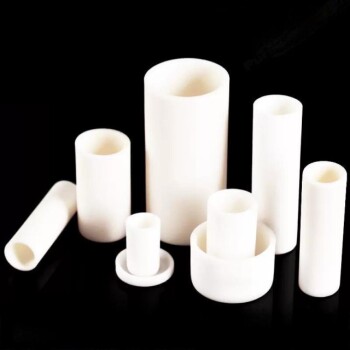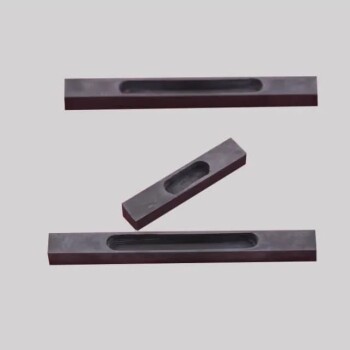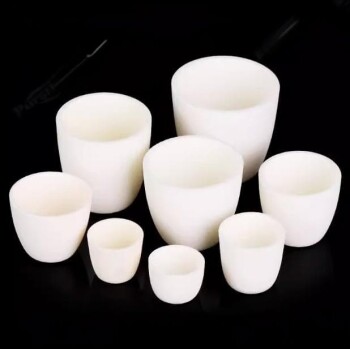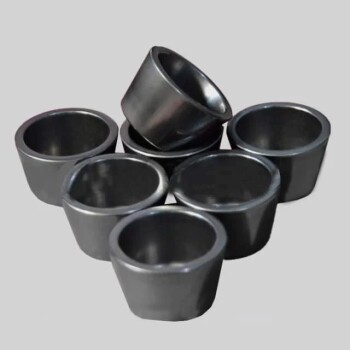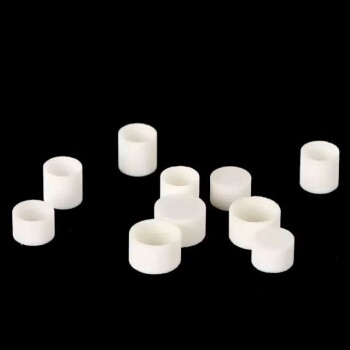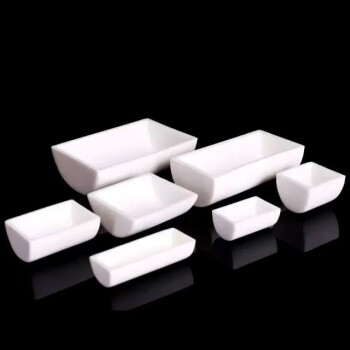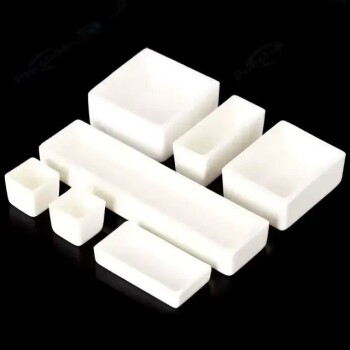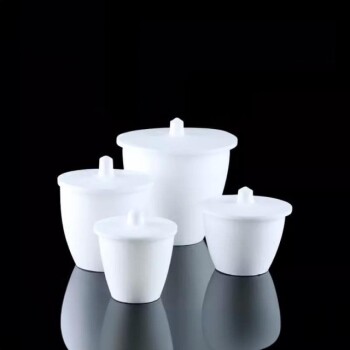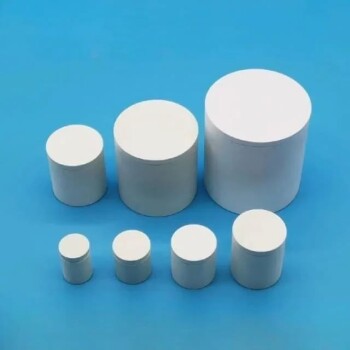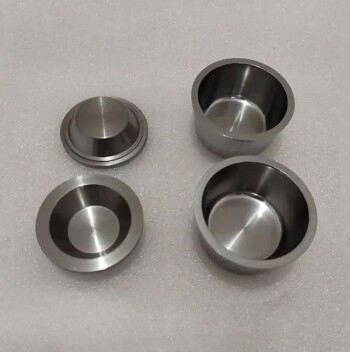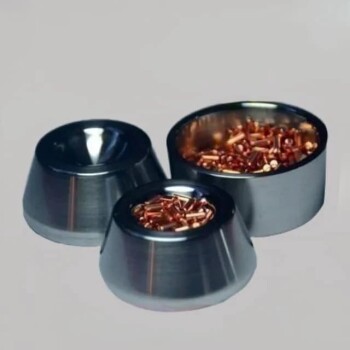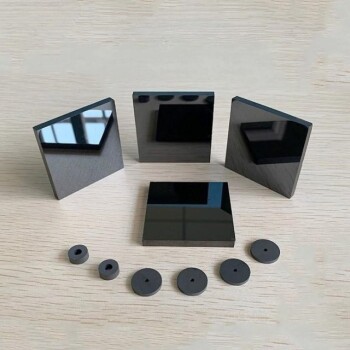The material used for an induction furnace crucible is not a single substance, but rather a selection of materials chosen based on the furnace's electrical characteristics and the specific metal being melted. While historical crucibles were made of clay, modern induction applications primarily use graphite, silicon carbide, and advanced ceramic composites. For highly reactive metals, specialized solutions like water-cooled copper crucibles are employed.
The central challenge is not simply finding a material that withstands heat. It is about matching the crucible's electrical properties to the furnace's operating frequency to ensure efficient and controlled heating of the metallic charge.
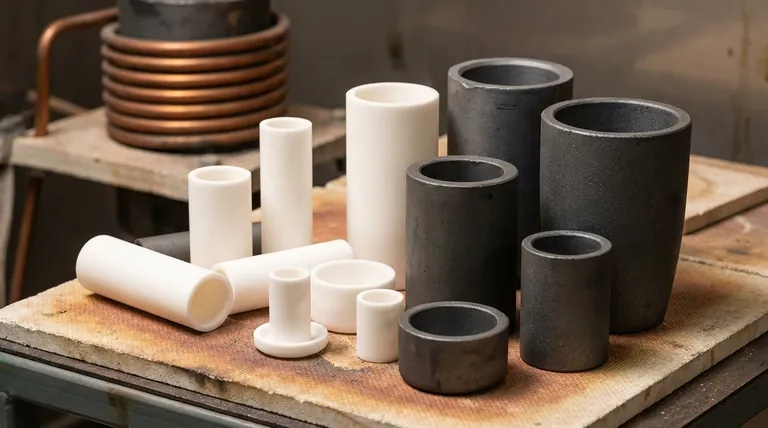
The Fundamental Choice: Conductive vs. Non-Conductive Crucibles
The primary distinction in crucible materials is whether they are electrically conductive or non-conductive (insulating). This choice fundamentally changes how the furnace's energy is transferred to the metal.
Conductive Crucibles (Graphite & Silicon Carbide)
Conductive crucibles are made from materials like graphite or silicon carbide.
When placed in the induction coil's magnetic field, these materials have electrical currents induced within them, causing them to heat up. This is known as resistive heating.
The crucible then acts as a primary heat source, transferring that heat to the metal charge inside via conduction and radiation. This method is effective for melting non-conductive materials or for furnaces where this two-step heating process is desired.
Non-Conductive / Insulating Crucibles (Ceramics)
Non-conductive or insulating crucibles are typically made from ceramic materials like high-purity alumina or clay-graphite mixtures with high clay content.
These materials are effectively "transparent" to the magnetic field. The field passes through the crucible walls with minimal interference and directly induces heating currents within the metallic charge itself.
This method provides very direct and efficient heating of the metal, making it a common choice for many melting applications.
How Furnace Frequency Dictates Material Choice
The operating frequency of the induction power supply is the most critical factor in crucible selection. The "skin effect" at different frequencies determines how the magnetic field couples with the crucible and the charge.
Low-Frequency Furnaces
Low-frequency induction furnaces require a crucible that can assist in the heating process.
The magnetic field at lower frequencies penetrates deeper, making it less efficient at directly coupling with smaller metal pieces. Therefore, a conductive crucible with high silicon carbide content is often used. The crucible heats up and provides the initial energy to start the melt.
High-Frequency Furnaces
High-frequency furnaces are very effective at directly inducing currents in the metal charge.
For these systems, a less conductive or insulating crucible is preferred to avoid intercepting the energy from the field. Crucibles with a high clay or alumina content are ideal, as they allow the magnetic field to pass through to the metal unimpeded.
Understanding the Trade-offs
Selecting a crucible involves balancing performance, lifespan, and potential contamination. No single material is perfect for every situation.
Chemical Reactivity and Melt Purity
The crucible material must be chemically inert with respect to the molten metal to avoid contamination.
For example, a graphite crucible can introduce carbon into a low-carbon steel melt, which is often undesirable. For ultra-high purity applications or when melting highly reactive metals, standard crucibles are unsuitable.
Thermal Shock and Durability
The crucible must withstand rapid temperature changes (thermal shock) without cracking. Materials like silicon carbide offer excellent thermal shock resistance.
The physical design, such as a cylindrical shape, also contributes to durability by ensuring a uniform distance and even heating from the furnace coil.
Cost vs. Performance
High-performance materials like pure zirconium or platinum, used in laboratories for their inertness, are prohibitively expensive for industrial-scale melting.
The choice for production environments is always a compromise between the initial cost of the crucible, its expected lifespan, and the required quality of the final melted product.
Crucibles for Specialized Applications
For unique challenges, highly specialized crucibles have been developed.
Melting Reactive Metals (Titanium, Zirconium)
Melting metals like titanium requires eliminating any reaction with the crucible. This is achieved using a water-cooled copper crucible.
A thin "skull" of solidified metal forms against the cold copper wall, creating a self-containing crucible of the very material being melted. This prevents any contamination.
Improving Melt Quality
For applications demanding extremely clean metal, prefabricated calcium oxide crucibles have been developed. These materials have a very low reactivity with many alloys, significantly improving the quality and purity of the final melt.
Making the Right Choice for Your Application
Your choice of crucible must be aligned with your equipment and your goal.
- If your primary focus is matching an existing furnace: Your most important task is to match the crucible's electrical properties to the furnace's operating frequency.
- If your primary focus is melting standard ferrous or non-ferrous metals: A clay-graphite or silicon-carbide composite crucible is likely the most balanced choice for cost and performance.
- If your primary focus is melting highly reactive metals like titanium: A water-cooled copper crucible is the industry-standard solution.
- If your primary focus is achieving maximum melt purity: Consider advanced ceramic options like calcium oxide or evaluate if a non-conductive crucible that allows for direct metal heating is a better fit.
Ultimately, selecting the right crucible is a technical decision that ensures efficiency, melt quality, and the operational safety of your induction furnace.
Summary Table:
| Crucible Type | Key Materials | Best For | Key Consideration |
|---|---|---|---|
| Conductive | Graphite, Silicon Carbide | Low-frequency furnaces, non-conductive charges | Crucible heats up to melt the metal |
| Non-Conductive | Alumina, Clay-Graphite | High-frequency furnaces, direct metal heating | Allows magnetic field to pass through |
| Specialized | Water-cooled Copper, Calcium Oxide | Reactive metals (e.g., Titanium), high-purity melts | Prevents contamination; 'skull' melting |
Struggling to find the perfect crucible for your specific application? The right choice is critical for efficiency, melt purity, and furnace longevity. KINTEK specializes in lab equipment and consumables, offering expert guidance to match your induction furnace with the ideal crucible material. Let our specialists help you optimize your melting process—contact us today for a personalized solution!
Visual Guide

Related Products
- Engineering Advanced Fine Ceramics Alumina Al2O3 Crucible With Lid Cylindrical Laboratory Crucible
- High Purity Pure Graphite Crucible for Evaporation
- Arc-Shaped Alumina Ceramic Crucible High Temperature Resistant for Engineering Advanced Fine Ceramics
- High Purity Pure Graphite Crucible for Electron Beam Evaporation
- Engineering Advanced Fine Ceramics Alumina Crucibles (Al2O3) for Thermal Analysis TGA DTA
People Also Ask
- What are the safety precautions of a crucible? Protect Your Lab from Thermal Shock and Hazards
- What precautions should be taken when using a crucible? Essential Steps for Safety and Accuracy
- How is a crucible used in the crucible? Unpacking Arthur Miller's Powerful Metaphor
- What temperature is an Al2O3 crucible? Key Factors for High-Temperature Success Up to 1700°C
- What needs to be checked before using a crucible? A Guide to Safe and Effective High-Temperature Work
